Page 188 of 539
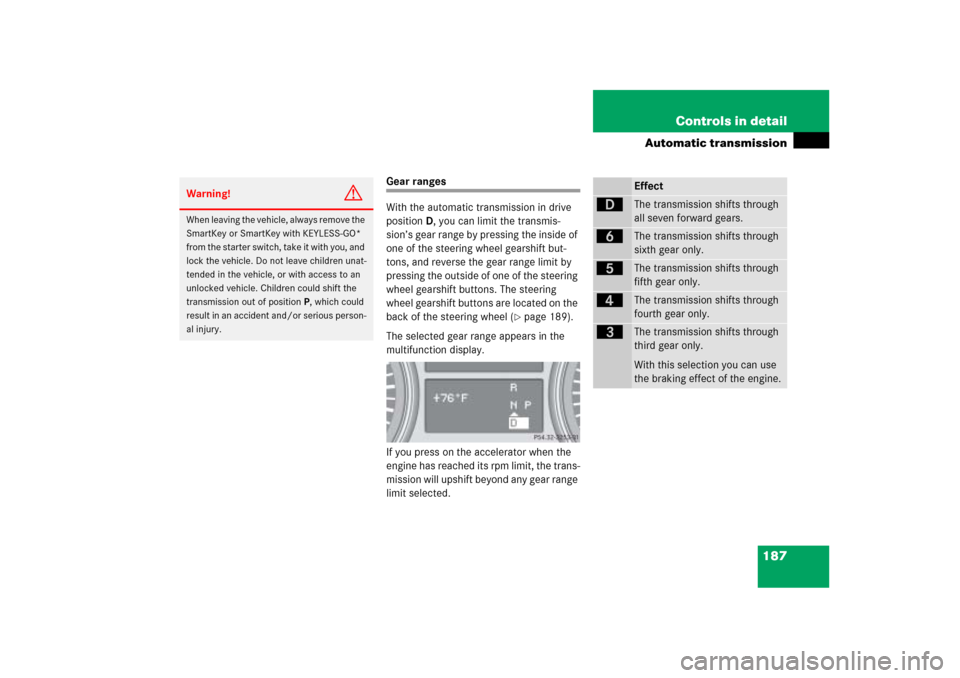
187 Controls in detail
Automatic transmission
Gear ranges
With the automatic transmission in drive
positionD, you can limit the transmis-
sion’s gear range by pressing the inside of
one of the steering wheel gearshift but-
tons, and reverse the gear range limit by
pressing the outside of one of the steering
wheel gearshift buttons. The steering
wheel gearshift buttons are located on the
back of the steering wheel (
�page 189).
The selected gear range appears in the
multifunction display.
If you press on the accelerator when the
engine has reached its rpm limit, the trans-
mission will upshift beyond any gear range
limit selected.
Warning!
G
When leaving the vehicle, always remove the
SmartKey or SmartKey with KEYLESS-GO*
from the starter switch, take it with you, and
lock the vehicle. Do not leave children unat-
tended in the vehicle, or with access to an
unlocked vehicle. Children could shift the
transmission out of positionP, which could
result in an accident and/or serious person-
al injury.
Effect
ê
The transmission shifts through
all seven forward gears.
ï
The transmission shifts through
sixth gear only.
î
The transmission shifts through
fifth gear only.
é
The transmission shifts through
fourth gear only.
è
The transmission shifts through
third gear only.
With this selection you can use
the braking effect of the engine.
Page 189 of 539
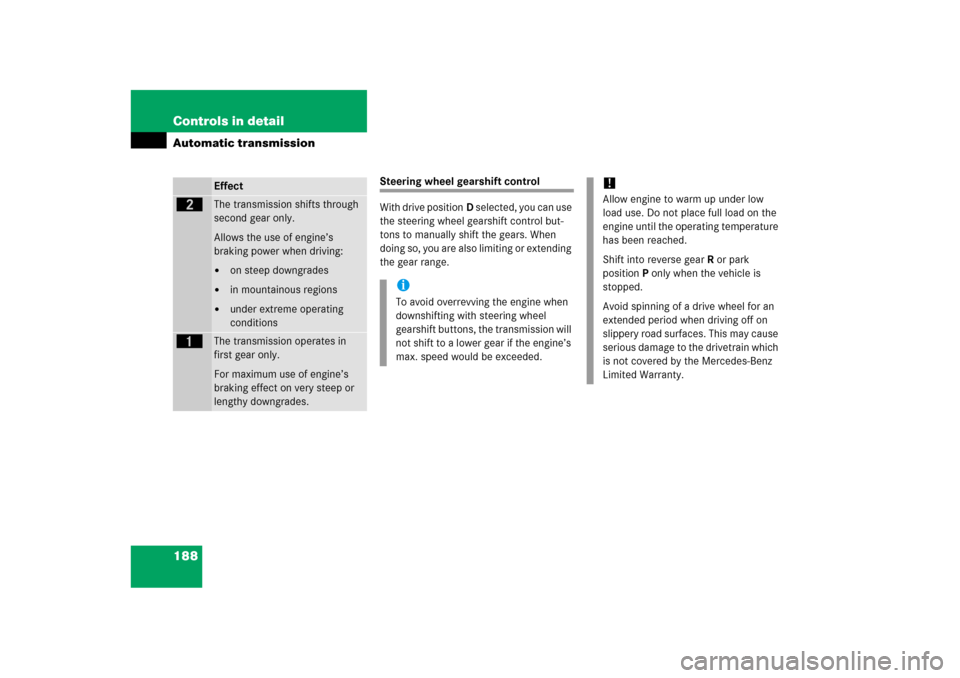
188 Controls in detailAutomatic transmission
Steering wheel gearshift control
With drive positionD selected, you can use
the steering wheel gearshift control but-
tons to manually shift the gears. When
doing so, you are also limiting or extending
the gear range.
Effect
ç
The transmission shifts through
second gear only.
Allows the use of engine’s
braking power when driving:�
on steep downgrades
�
in mountainous regions
�
under extreme operating
conditions
æ
The transmission operates in
first gear only.
For maximum use of engine’s
braking effect on very steep or
lengthy downgrades.
iTo avoid overrevving the engine when
downshifting with steering wheel
gearshift buttons, the transmission will
not shift to a lower gear if the engine’s
max. speed would be exceeded.
!Allow engine to warm up under low
load use. Do not place full load on the
engine until the operating temperature
has been reached.
Shift into reverse gearR or park
positionP only when the vehicle is
stopped.
Avoid spinning of a drive wheel for an
extended period when driving off on
slippery road surfaces. This may cause
serious damage to the drivetrain which
is not covered by the Mercedes-Benz
Limited Warranty.
Page 191 of 539
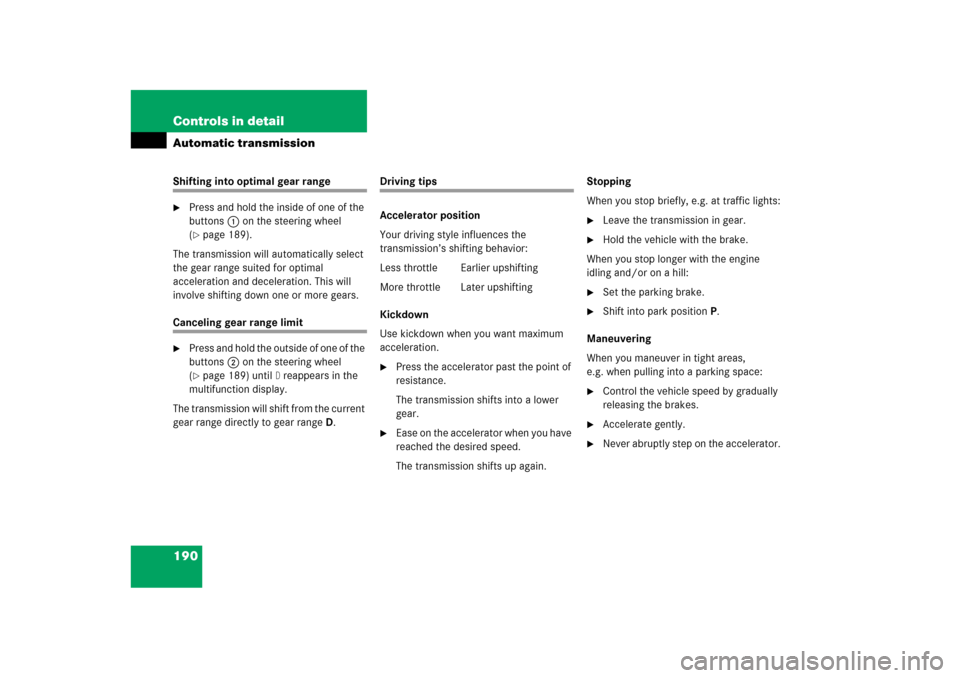
190 Controls in detailAutomatic transmissionShifting into optimal gear range�
Press and hold the inside of one of the
buttons1 on the steering wheel
(�page 189).
The transmission will automatically select
the gear range suited for optimal
acceleration and deceleration. This will
involve shifting down one or more gears.
Canceling gear range limit�
Press and hold the outside of one of the
buttons2 on the steering wheel
(�page 189) until
D reappears in the
multifunction display.
The transmission will shift from the current
gear range directly to gear rangeD.
Driving tips
Accelerator position
Your driving style influences the
transmission’s shifting behavior:
Less throttle Earlier upshifting
More throttle Later upshifting
Kickdown
Use kickdown when you want maximum
acceleration.�
Press the accelerator past the point of
resistance.
The transmission shifts into a lower
gear.
�
Ease on the accelerator when you have
reached the desired speed.
The transmission shifts up again.Stopping
When you stop briefly, e.g. at traffic lights:
�
Leave the transmission in gear.
�
Hold the vehicle with the brake.
When you stop longer with the engine
idling and/or on a hill:
�
Set the parking brake.
�
Shift into park positionP.
Maneuvering
When you maneuver in tight areas,
e.g. when pulling into a parking space:
�
Control the vehicle speed by gradually
releasing the brakes.
�
Accelerate gently.
�
Never abruptly step on the accelerator.
Page 192 of 539

191 Controls in detail
Automatic transmission
Rocking the vehicle
Rocking the vehicle by shifting betweenD
andR can help free a vehicle stuck in mud
or snow. The engine control system of this
vehicle electronically limits shifting
betweenD andR to very low speeds
(i.e. approx. 2 mph). To shift betweenD
andR, move the gear selector lever past
the resistance point up or down.
Hill start assist system
On uphill grades, the hill start assist
system maintains the pressure in the
brake system for approximately
one second after you have released the
brake pedal. Therefore, you can start off
smoothly without the vehicle moving im-
mediately after releasing the brake pedal.
The hill start assist system is inactive�
on driving downhill
�
in positionN
�
with the parking brake setWorking on the vehicle
Towing a trailer
If you tow a trailer, note the following
points:�
Manually shift to a lower gear range
(�page 187) if the transmission hunts
between gears on inclines.
A lower gear range and reduction of
speed reduces the chance to overload
or overheat the engine.
For more information on trailer towing, see
the “Operation” section (
�page 314).
Warning!
G
The hill start assist system is not designed
to function as a parking brake and does not
prevent the vehicle from moving when
parked on an incline.
Always set the parking brake in addition to
shifting to park position
P.
iIf the ESP
® has switched off due to a
malfunction, the hill start assist system
is also unavailable.
Warning!
G
When working on the vehicle, set the
parking brake and shift to park positionP.
Otherwise the vehicle could roll away.
Page 193 of 539
192 Controls in detailAutomatic transmissionEmergency operation (Limp Home Mode)
If vehicle acceleration worsens or the
transmission no longer shifts, the trans-
mission is most likely operating in limp
home (emergency operation) mode. In this
mode only second gear and reverse gear
can be activated.�
Stop the vehicle.
�
Shift to park positionP.
�
Turn off the engine.
�
Wait at least ten seconds before
restarting.
�
Restart the engine.
�
Shift to drive positionD (for second
gear) or reverse gearR.
�
Have the transmission checked at an
authorized Mercedes-Benz Light Truck
Center as soon as possible.
Page 194 of 539
193 Controls in detail
Transfer case
�Transfer case
For more information on Off-road driving,
see “Off-road driving” (
�page 306).
!Because off the ESP’s
® automatic
operation, the engine must be shut off
(SmartKey or SmartKey with
KEYLESS-GO* in starter switch
position1) when testing the brakes on
a brake test dynamometer and such
testing should be no longer than
10 seconds. Active braking action
through the ESP
® may otherwise
seriously damage the front or rear axle
brake system.
Operational or performance tests with
the engine running must only be con-
ducted on a two-axle dynamometer.
Otherwise, the transfer case or the
brake system can be damaged, which
is not covered by the Mercedes-Benz
Limited Warranty.
iThe vehicle is equipped with full-time
four-wheel drive. Both the front and
rear axles are powered at all times
when the vehicle is being operated.
Page 206 of 539
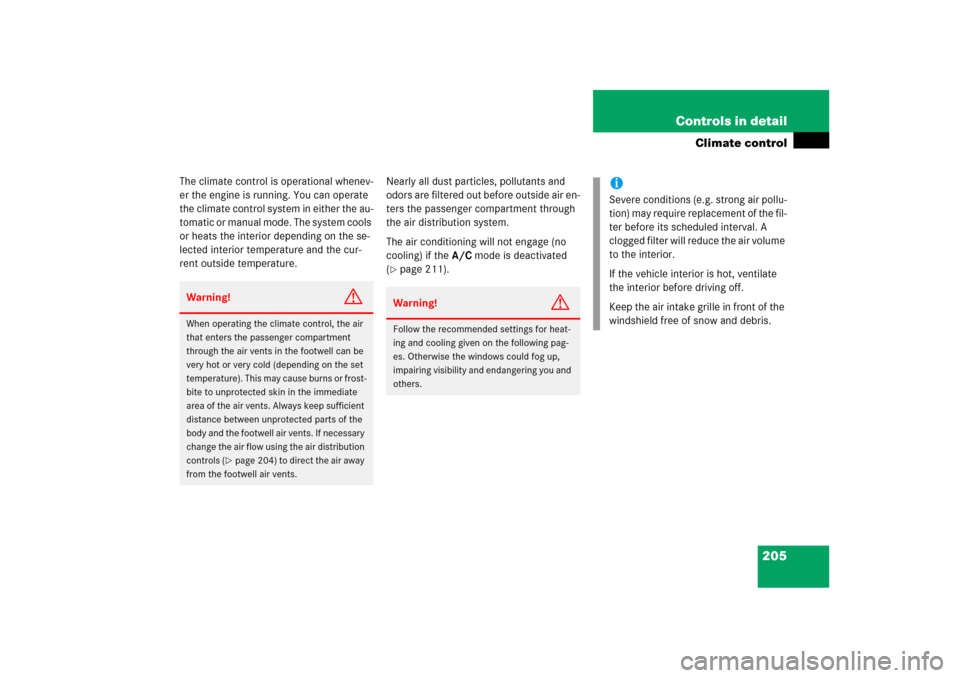
205 Controls in detail
Climate control
The climate control is operational whenev-
er the engine is running. You can operate
the climate control system in either the au-
tomatic or manual mode. The system cools
or heats the interior depending on the se-
lected interior temperature and the cur-
rent outside temperature.Nearly all dust particles, pollutants and
odors are filtered out before outside air en-
ters the passenger compartment through
the air distribution system.
The air conditioning will not engage (no
cooling) if the A/C mode is deactivated
(
�page 211).
Warning!
G
When operating the climate control, the air
that enters the passenger compartment
through the air vents in the footwell can be
very hot or very cold (depending on the set
temperature). This may cause burns or frost-
bite to unprotected skin in the immediate
area of the air vents. Always keep sufficient
distance between unprotected parts of the
body and the footwell air vents. If necessary
change the air flow using the air distribution
controls (
�page 204) to direct the air away
from the footwell air vents.
Warning!
G
Follow the recommended settings for heat-
ing and cooling given on the following pag-
es. Otherwise the windows could fog up,
impairing visibility and endangering you and
others.
iSevere conditions (e.g. strong air pollu-
tion) may require replacement of the fil-
ter before its scheduled interval. A
clogged filter will reduce the air volume
to the interior.
If the vehicle interior is hot, ventilate
the interior before driving off.
Keep the air intake grille in front of the
windshield free of snow and debris.
Page 212 of 539
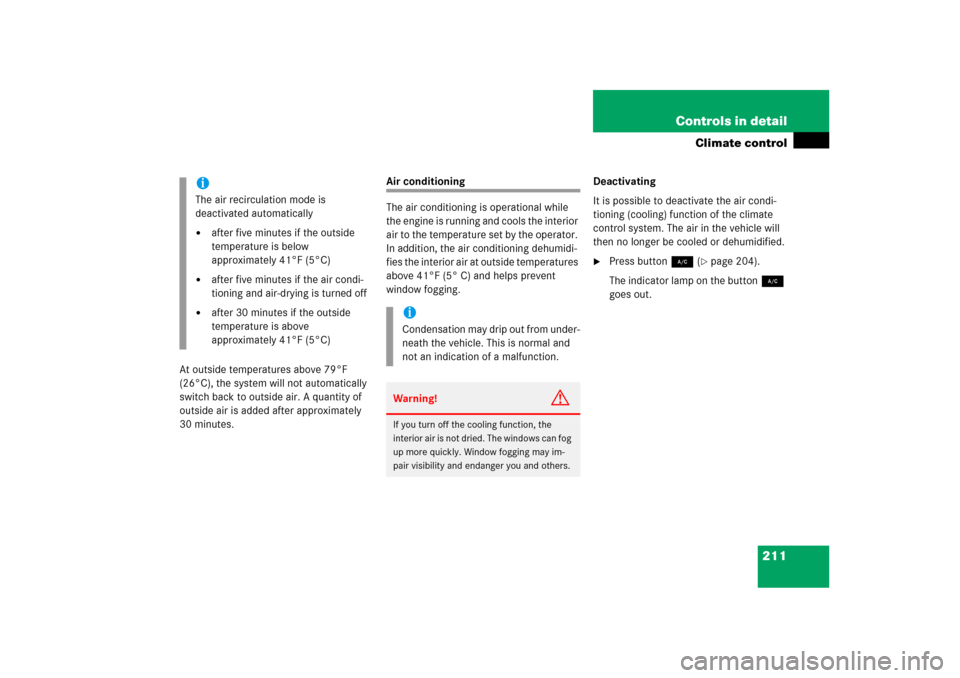
211 Controls in detail
Climate control
At outside temperatures above 79°F
(26°C), the system will not automatically
switch back to outside air. A quantity of
outside air is added after approximately
30 minutes.
Air conditioning
The air conditioning is operational while
the engine is running and cools the interior
air to the temperature set by the operator.
In addition, the air conditioning dehumidi-
fies the interior air at outside temperatures
above 41°F (5° C) and helps prevent
window fogging.Deactivating
It is possible to deactivate the air condi-
tioning (cooling) function of the climate
control system. The air in the vehicle will
then no longer be cooled or dehumidified.
�
Press button2 (
�page 204).
The indicator lamp on the button2
goes out.
iThe air recirculation mode is
deactivated automatically�
after five minutes if the outside
temperature is below
approximately 41°F (5°C)
�
after five minutes if the air condi-
tioning and air-drying is turned off
�
after 30 minutes if the outside
temperature is above
approximately 41°F (5°C)
iCondensation may drip out from under-
neath the vehicle. This is normal and
not an indication of a malfunction.Warning!
G
If you turn off the cooling function, the
interior air is not dried. The windows can fog
up more quickly. Window fogging may im-
pair visibility and endanger you and others.